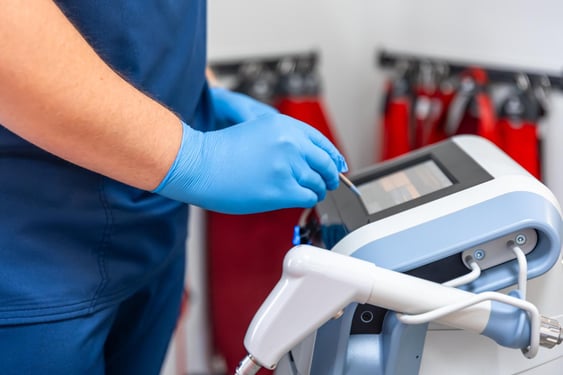February 21, 2024
CPT Code for Cryotherapy: Differences Between 97010 vs. 97016
Cryotherapy, the application of cold therapy to reduce inflammation and pain, is a widely used modality in physical therapy. However, navigating the appropriate CPT code for billing purposes can be tricky.
This article dives into the two frequently used codes for cryotherapy: 97010 and 97016, exploring their definitions, appropriate applications, and reimbursement considerations.
Understanding CPT Codes 97010 and 97016
- 97010 - Cryotherapy Application: This code describes the "application of cold packs or cold compresses to a localized area of the body." This typically involves wrapping a cold pack around the affected area for a controlled period.
- 97016 - Vasopneumatic Compression Therapy: This code encompasses "the application of intermittent pneumatic compression devices to the extremities for the purpose of edema reduction, wound healing, and pain management." It applies to specialized mechanical devices that intermittently inflate and deflate sleeves or wraps around limbs.
Key Differences and Choosing the Right Code
The defining factor lies in the modality employed:
- 97010 applies to passive treatment using simple cold packs or compresses.
- 97016 is reserved for active treatment utilizing specialized vasopneumatic compression devices.
Misconceptions and Clarifications
Myth: All cryotherapy falls under code 97010. This is incorrect. The modality used differentiates between codes.
Clarification #1: Code 97010 does not encompass ice massage, as it requires active manipulation by the therapist.
Clarification #2: While some vasopneumatic devices may have a cooling component, the code focuses on the compression aspect, making 97016 appropriate.Reimbursement Considerations
Medicare and many private payers only reimburse code 97016 consistently. Reimbursement for 97010, especially for simple cold pack applications, is often minimal or non-existent.
Documentation is crucial for justifying medical necessity and ensuring proper reimbursement. Document the specific modality used, treatment duration, and rationale for choosing that modality.
Consider bundling for treatments involving both modalities, bundling might be appropriate depending on payer guidelines. Consult your billing specialist for specific guidance.
Additional Considerations
- State licensing regulations: Some states may have specific requirements for using vasopneumatic devices.
- Patient safety and comfort: Ensure proper application and monitoring of both modalities to avoid adverse effects.
Beyond Reimbursement: Exploring the Clinical Significance

While reimbursement is a critical factor, remember that the choice of modality should primarily be based on clinical reasoning and patient needs.
- 97010 (cold packs) may be suitable for:
- Acute injuries with short-term inflammation.
- Superficial pain relief.
- Localized muscle spasms.
- 97016 (vasopneumatic therapy) may be beneficial for:
- Lymphedema management.
- Chronic pain management.
- Wound healing promotion.
- Edema reduction after surgery.
Remember: Consult evidence-based practice guidelines and consider patient-specific factors when choosing a modality.
Bottom Line
Understanding the nuances of CPT codes 97010 and 97016 is crucial for physical therapy professionals to ensure accurate billing and optimize patient care. By carefully considering the modality used, its clinical indication, and documentation practices, you can navigate the reimbursement landscape while prioritizing effective treatment strategies.
Ensuring Right CPT Code Usage and Billing, Everytime
PtEverywhere stands out as a valuable tool for billing CPT codes in physical therapy practices. Its intuitive interface streamlines the billing process, allowing practitioners to easily select the appropriate code for cryotherapy sessions, such as 97010 or 97016.
With PtEverywhere, therapists can accurately document the specific modality used, treatment duration, and rationale, enhancing documentation for medical necessity.
Additionally, PtEverywhere provides insights into payer guidelines, helping practices maximize reimbursement by bundling appropriate treatments and ensuring compliance with state regulations.


